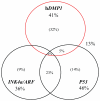Signal transduction involving the dmp1 transcription factor and its alteration in human cancer
- PMID: 21892281
- PMCID: PMC3161675
- DOI: 10.4137/cmo.s548
Signal transduction involving the dmp1 transcription factor and its alteration in human cancer
Abstract
Dmp1 (cyclin D-interacting myb-like protein 1; also called Dmtf1) is a transcription factor that has been isolated in a yeast two-hybrid screen through its binding property to cyclin D2. Dmp1 directly binds to and activates the Arf promoter and induces Arf-p53-dependent cell cycle arrest in primary cells. D-type cyclins usually inhibit Dmp1-mediated transcription in a Cdk-independent fashion; however, Dmp1 shows synergistic effects with D-cyclins on the Arf promoter. Ras or Myc oncogene-induced tumor formation is accelerated in both Dmp1(+/-) and Dmp1(-/-) mice with no significant differences between Dmp1(+/-) and Dmp1(-/-). Thus, Dmp1 is haplo-insufficient for tumor suppression. Tumors from Dmp1(-/-) or Dmp1(+/-) mice often retain wild-type Arf and p53, suggesting that Dmp1 is a physiological regulator of the Arf-p53 pathway. The Dmp1 promoter is activated by oncogenic Ras-Raf signaling, while it is repressed by physiological mitogenic stimuli, overexpression of E2F proteins, and genotoxic stimuli mediated by NF-κB. The human DMP1 gene (hDMP1) is located on chromosome 7q21 and is hemizygously deleted in approximately 40% of human lung cancers, especially those that retain normal INK4a/ARF and P53 loci. Thus, hDMP1 is clearly involved in human carcinogenesis, and tumors with hDMP1 deletion may constitute a discrete disease entity.
Keywords: Arf; Dmp1; Ras; haplo-insufficiency; lung cancer; p53.
Figures




Similar articles
-
Dmp1 and tumor suppression.Oncogene. 2007 Jun 28;26(30):4329-35. doi: 10.1038/sj.onc.1210226. Epub 2007 Jan 22. Oncogene. 2007. PMID: 17237816 Free PMC article. Review.
-
Role of DMP1 and its future in lung cancer diagnostics.Expert Rev Mol Diagn. 2008 Jul;8(4):435-47. doi: 10.1586/14737159.8.4.435. Expert Rev Mol Diagn. 2008. PMID: 18598225 Free PMC article. Review.
-
Mutually exclusive inactivation of DMP1 and ARF/p53 in lung cancer.Cancer Cell. 2007 Oct;12(4):381-94. doi: 10.1016/j.ccr.2007.08.034. Cancer Cell. 2007. PMID: 17936562 Free PMC article.
-
Ras-Raf-Arf signaling critically depends on the Dmp1 transcription factor.Mol Cell Biol. 2005 Jan;25(1):220-32. doi: 10.1128/MCB.25.1.220-232.2005. Mol Cell Biol. 2005. PMID: 15601844 Free PMC article.
-
Critical roles of DMP1 in human epidermal growth factor receptor 2/neu-Arf-p53 signaling and breast cancer development.Cancer Res. 2010 Nov 15;70(22):9084-94. doi: 10.1158/0008-5472.CAN-10-0159. Epub 2010 Nov 9. Cancer Res. 2010. PMID: 21062982 Free PMC article.
Cited by
-
Transgenic and knockout mice models to reveal the functions of tumor suppressor genes.Clin Med Insights Oncol. 2011;5:235-57. doi: 10.4137/CMO.S7516. Epub 2011 Jul 28. Clin Med Insights Oncol. 2011. PMID: 21836819 Free PMC article.
-
Classical and Novel Prognostic Markers for Breast Cancer and their Clinical Significance.Clin Med Insights Oncol. 2010 Apr 20;4:15-34. doi: 10.4137/cmo.s4773. Clin Med Insights Oncol. 2010. PMID: 20567632 Free PMC article.
-
Dmp1α inhibits HER2/neu-induced mammary tumorigenesis.PLoS One. 2013 Oct 29;8(10):e77870. doi: 10.1371/journal.pone.0077870. eCollection 2013. PLoS One. 2013. PMID: 24205004 Free PMC article.
-
Human DMTF1β antagonizes DMTF1α regulation of the p14(ARF) tumor suppressor and promotes cellular proliferation.Biochim Biophys Acta. 2015 Sep;1849(9):1198-208. doi: 10.1016/j.bbagrm.2015.07.009. Epub 2015 Jul 15. Biochim Biophys Acta. 2015. PMID: 26187004 Free PMC article.
-
Clinical applications of mouse models for breast cancer engaging HER2/neu.Integr Cancer Sci Ther. 2016;3(5):593-603. doi: 10.15761/ICST.1000210. Epub 2016 Oct 28. Integr Cancer Sci Ther. 2016. PMID: 28133539 Free PMC article.
References
-
- Adnane J, Shao Z, Robbins PD. Cyclin D1 associates with the TBP-associated factor TAF(II)250 to regulate Sp1-mediated transcription. Oncogene. 1999;18:239–47. - PubMed
-
- Arnold A, Papanikolau A. Cyclin D1 in breast pathogenesis. J Clin Oncol. 2006;23:4215–24. - PubMed
-
- Bernards R. CDK-independent activities of D type cyclins. Biochem Biophys Acta. 1999;1424(2–3):M17–22. - PubMed
-
- Bieche I, Champeme MH, Matifas F, Hacene K, Callahan R, Lidereau R. Loss of heterozygosity on chromosome 7q and aggressive primary breast cancer. Lancet. 1992;339:139–43. - PubMed
Grants and funding
LinkOut - more resources
Full Text Sources
Research Materials
Miscellaneous

